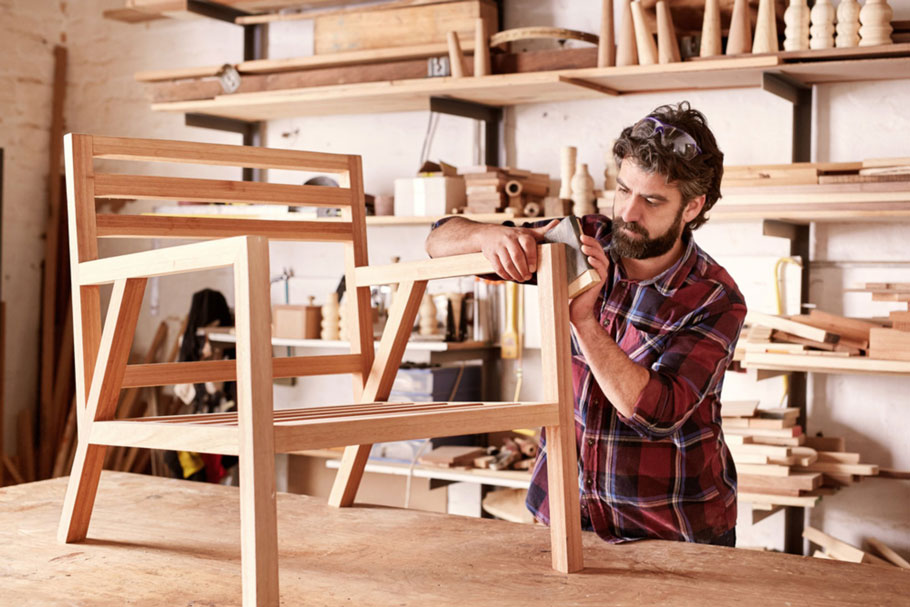
Consumers, more so now than ever, are increasingly concerned about resources and what it means for future generations. That’s the good news.
The “bad” news is that sustainable & environmental-friendly home are far from being “mainstream” and that limits the choices for those of us who put the Planet first. That options you have are particularly scarce when it comes to furniture.
Today, we’ll try to address that with a few tips on how to go about choosing the right pieces without sacrificing the aesthetics of the space.
What is eco-friendly furniture in the first place?
The principles of sustainable furniture are based on a loop-cycle and recycling – simply put, a furniture piece that can be used over and over.
It comes down to choosing reclaimed and natural materials such as wood coated in non-toxic stains are preferable over single-use-only plastics.
More than just a friend of the environment
Eco-friendly furniture is better for your health, too. Modern man spends a large chunk amount of time inside her/his home. The EPA (Environmental Protection Agency) studies have found air quality inside houses to be 2-5 times more polluted than outside.
The crux of the matter
Sustainable living means finding ways to reduce your carbon footprint. For example, buying goods such as furniture imported from another country involves transportation and energy consumption for the delivery and will leave a massive carbon footprint.
First things first – when considering environmentally friendly pieces, the first thing to look at is info about where it was made.
While many furniture companies scramble to find low cost labor in China and India, there are exceptions of eco-conscious companies that make their products locally.
There are companies in the wood industry that are willing to go the extra mile and adhere to the guidelines by The Nature Conservancy’s Plant a Billion Trees program.
As Dan from DC Norwood puts it “The veterans of the wood industry know what responsibility is about. It’s not about adhering to standards so that you brag about it on your website. It’s about giving back. It’s about making sure that my son can do what I do in 30 years without feeling guilty.”
This means that for every order new trees are planted. That’s substantiality at it’s best.
When it Comes to the Environment, Less is Best
Flexibility is the key when it comes to living with minimum furniture. Pieces of furniture that serve more than one purpose can greatly enhance the environment in which you live, but also cut down on waste items with single usage.
The Choice of Eco-friendly Materials
When looking for new furniture it is important to consider the materials it is made from. Metal, cloth, glass, and wood are earth friendly, natural materials. Some plastic bottles can take up to 1000 years to biodegrade, and 90% of plastic bottles are not recycled.
Deforestation has been a problem throughout the world. Trees benefit the planet in absorbing carbon dioxide and keeping surface temperatures cooler. Not only are they vital for bird, insect, and animal life, forests stabilize soil from erosion while leaf litter replenishes nutrients. The FSC (Forest Stewardship Council) sets standards when it comes to felling timber and replenishing forests.
Bamboo
Bamboo is a fast growing plant that needs little or no pesticides or chemicals to aid its growth. Technically, bamboo is grass, but the variety is vast with species such as Culms Giganteus which can grow to 114ft tall. Bamboo can be molded into shape, flattened for flooring and veneers, or used as a construction material because of its strength.
Concerns over the amount of water needed to grow bamboo have been raised by some environmentalist. Another concern over bamboo veneers is with formaldehyde glues used in the process.
Handcrafted bamboo furniture has a lustrous texture and smooth to touch.
Making eco-friendly choices doesn’t mean giving up what you love
Over the years, being vigilant about what you use was somehow shadowed with the vague impressions that it means giving up most of the things you love. That’s far fro reality.
Let’s say, for the purposes of this article, that you’re love camping or hiking. Most of the gear in the industry is made of material with a substantial carbon footprint. It’s materials like PVC and plastic that are most commonly used for your tents and air mattresses.
It’s not about giving up everything; it’s about adjusting your choices
Let’s take the choice of an air mattress as an example. Most commonly, these pieces that will be essential for a camper are made of PVC. In theory, that would make your chances of making an eco-friendly choice slim to none.
That’s not really the case because there are alternatives to PVC. Some of the best air mattresses out there are made from TPU fabric, which has much lower carbon footprint and it’s easy to recycle. It’s just a mater of taking the time to do your research and know what’s what. The key if finding the right source of reference information – for the example above a simple online search will show you some relevant results – like this list of best air mattresses on TheSleepStudies.com, which includes TPU airbeds.
Will It Last and What Happens Next
All furniture has a limited life. Either it no longer meets your needs, or it breaks. An eco-friendly consideration would be if the furniture is repairable, or can it be re-purposed as something else.
Another option is to sell furniture on eBay, Craigslist, or Freecycle and given a second life; your old belongings could be another’s treasure.
Up-cycling
Up-cycling means an old piece of furniture can be remodeled into something useful. An important part of green furniture is the ease with which it can be dismantled for recycling its components.
Furniture that is fused and melded from a variety of materials making it impossible to pull apart should be considered a bad choice.
Wood, on the other hand, is a durable material to last decades. A well made wooden table, even though out of fashion, will find a use by someone.
The Cradle to Cradle framework has been developed over the past two decades by MDBC as a certification for products with the goal of being ‘less bad’ but also ‘more good’ for the people inhabiting this planet.
Furniture and Toxicity
VOCs is the name for Volatile Organic Compounds. An example of a volatile compound is methane, a polluting gas from cow manure basses and wetlands. It’s harmful when emitted in the home via paint, carpets, cleaning agents, and furniture. The volatile part of VOCs is when products vaporize, leaving their original material, and become airborne forming ozone.
Concentrations of VOCs can be up to 1,000 times greater inside a home than outside. The process is called off-gassing and is bad for your health. In high concentrations, it is known to be a carcinogen.
Look for Greenguard Certified furniture. Natural, unfinished wood, organic cotton, and naturally tanned leather are all good ways to avoid off-gassing.
Flame Retardants
While many fire retardants are banned in Europe, the US under the REACH program sees almost all furniture treated with retardants.
According to fire expert Vytenis Babrauskas, retardants in foam “are not effective enough to make them stop burning rapidly once they’re ignited. But they are effective in polluting the environment and creating health concerns.”
The scary part about fire retardants is how they migrate from furniture into the environment. The Consumer Federation of California wants standards changed.
A number of Californians tested were found to have ‘bio-accumulated brominated flame retardants’ stored in their bodies. Toxins in these chemicals affect humans and animals with hormone disruption, reproductive toxicity, cancer and fetal development.
Many scientists argue fire level safety can be achieved with using harmful bromides.
It’s simply wise
Choosing eco-friendly furniture is about vigilance and a keen-eye.
Done right, it could also be the wisest choice when it comes to individual and family health. But more importantly, clever design, locally made furniture will have style and functionality appreciated for its life, and the next life to come.





Leave a Comment